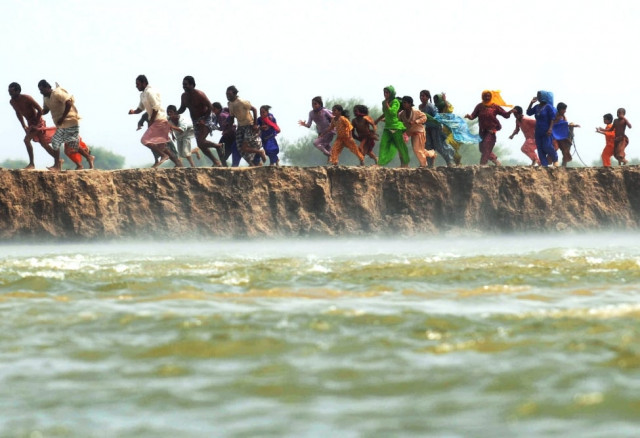Deja vu: The monsoons arrive late, but Sindh still sinks
Hundreds of houses washed away and thousands find themselves homeless for Eid.

About 20 people have died while dozens were injured in the last three days as monsoon rains swept through upper Sindh. Villages have been inundated and an estimated 700 kachcha houses collapsed in the downpour which begun the day before Eidul Fitr and is yet to let up.
Reports place Khairpur atop the list of the most affected districts of upper Sindh. Here, rains have wreaked havoc across the area, particularly in Nara Taluka where villages have been swept away in hill torrents leaving thousands homeless and to take shelter on high grounds and sand dunes. In many areas, drains have developed breaches flooding low lying areas with saline water.
Torrential rainfall started simultaneously in upper Sindh lashing through Sukkur, Rohri, Pannu Aqil, Ghotki, Mirpur Mathelo, Ubauro, Daharki, Khanpur Mahar, Thull, Jacobabad, Kashmore, Kandhkot, Shikarpur, Khanpur, Lakhi Ghulam Shah, Madeji, Garhi Yasin, Khairpur, Naushahro Feroze and other areas on the evening of August 30. The rain collected quickly and, in a matter of minutes, almost all the main roads and streets were submerged and water began seeping into houses in low lying areas.
The electricity supply was disrupted when the rain first began and people had to deal with the situation in the dark for up to 48 hours.
In Mirzapur village, the roof of Saadullah Phulpoto’s kachcha house caved in on the second day of Eid killing three of his children, Mazhar, eight, Fauzia, six and Athar, three. He, his wife, Farzana, daughter Shazia, and son Azhar, five, were injured. Similarly, an elderly woman died when the wall of her house in Khairpur collapsed and another two women were injured in a roof collapse in Khanpur Mahar Town.
Meanwhile, at least four people died and 20 were injured in Sakrand. Houses were blown away and trees uprooted. One-year-old Jaro, 25-year-old Aslam Rind, Amina Khaskheli and 65-year-old Gullan Khaskheli died of electrocution and as a result of roof collapses. Two people - Sadia, five, and Ghulam Rasool Lashari, 25 - died while 23 people were injured in Tando Adam and its surrounding areas in the last three days. In Nawabshah, six people died in over five cave-ins. Survivors have flocked to makeshift relief camps as the People’s Medical College, police stations, Police Headquarters, Highway Office, Telecom Building, District Jail and other buildings which may have served as shelters have all flooded.
At least four people died in roof collapses in the Shahdadkot district.
Protests and desperation
Hundreds of villagers camped out at the Talhar-Badin Road near Peero Lashari and blocked traffic after the rain destroyed their houses and crops. Law enforcers opened fire to disperse them, injuring three villagers, Ashraf Gelaro, Shahbasz and Muhammad Hussain, who were rushed to Civil Hospital, Badin. The rally broke up after police and administration officers spoke with the protesters. Livestock has also suffered with a large number dying in the excess rain. However, the most pressing concern remains the unavailability of fuel. Coal and firewood supplies are all soaked through and there is nothing to use to cook food.
Crops suffer
Enormous damage has been caused to the areas’ main produce — rice paddy, sugarcane and cotton — worth millions of rupees. Ghotki, Jacobabad, Kashmore, Shikarpur and Khairpur’s fields are all lost under two to four feet of water. Vegetable crops have also been damaged considerably.
Agriculture experts such as GM Khoso, Mandhal Shar, Mohammad Bux Sundrani and Ghulam Hussain Mahar fear that the timing of this year monsoon has caused enormous losses. The late arrival of the rains meant the floods came when the crops, especially sugarcane and cotton, were almost ready to be harvested.
Meanwhile, about two feet of rainwater mixed with sewerage is accumulating in Sukkur, Rohri, Ali Wahan and Salehpat because of a faulty drainage system.
“It seems that big holes have been punched in the sky and water is coming down constantly,” lamented the elderly Mai Bhagul as she bailed water out of her house. The mud-plastered roof of her kachcha house had developed cracks and holes through which water was dripping in.
“I haven’t experienced such rain in the last 20 to 25 years,” she said, “it seems like it will never stop.” Mai Bhagul’s son was out calling on some friends and her daughter-in-law was busy preparing meals, but the old woman was committed to rain out rain water completely.
In her late 80s, she appeared too old for such menial labour but kept at it with dogged determination chatting away about home-remedies to rain.
“You know what?” she remarked jokingly. “My mother used to throw a closed lock and a fan made of date leaves in the courtyard to stop the rain. Others used to recite the azaan.”
Another common protection against the evils of rain was to tie verses of the Holy Quran to the date tree branches to avoid rainfall.
The effectiveness of the methods is still up for debate, she laughed. “Sometimes they worked.”
With additional information
from PPI
Rain figures for Sindh and Balochistan
Kalat 88.0 mm
Nawabshah 67.0mm
Padidan 57.0mm
Mirpurkhas 50.0mm
Dadu 48.0mm
Mithi 43.0mm
Hyderabad 27.5mm
Moenjodro 26.0mm
Sukkur 16.3mm
Rohri 12.0mm
Larkana 11.0mm
Barkhan 10.0mm
Sibi 9.0mm
Thatta 6.0mm
Chore 5.1mm
Quetta 2.0mm
Jacobabad 1.8mm
Traces of rainfall reported from Lasbella.
Published in The Express Tribune, September 3rd, 2011.



















COMMENTS
Comments are moderated and generally will be posted if they are on-topic and not abusive.
For more information, please see our Comments FAQ